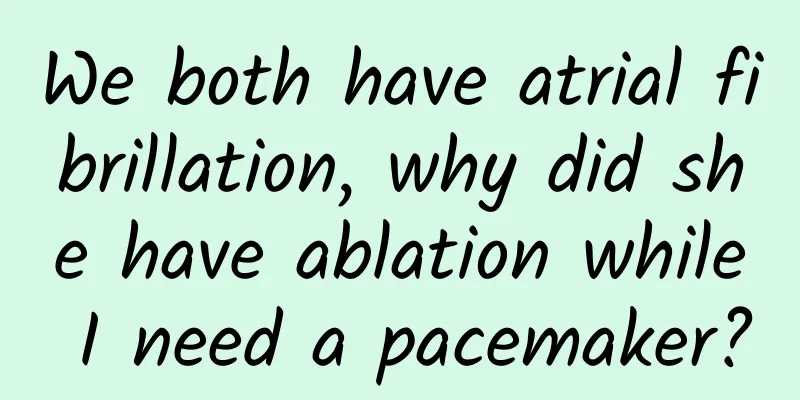We both have atrial fibrillation, why did she have ablation while I need a pacemaker?

|
Author: Zhao Yikai, Huashan Hospital Affiliated to Fudan University Jiang Sining Huashan Hospital Affiliated to Fudan University Reviewer: Li Jian, Chief Physician, Huashan Hospital Affiliated to Fudan University Aunt Zhang, 68, often felt weak and dizzy. She suddenly fainted in the market and was panicked for a long time after waking up. On the same day, at the suggestion of a cardiologist, she underwent a Holter test that can monitor the heart's electrical activity for 24 hours. Aunt Zhang was confused when she took the Holter report. Figure 1 Copyright image, no permission to reprint The report stated: A total of 62,054 heart beats in 24 hours, with an average heart rate of 43 beats/minute, paroxysmal atrial fibrillation, of which bradycardia events (heart rate <50 beats/minute) lasted 75% of the total time, with a total of 48 long intervals and the longest arrest time of 5.56 seconds. The cardiologist suggested that Aunt Zhang be hospitalized immediately to have a pacemaker installed. "Atrial fibrillation is combined with severe cardiac arrest. It is too dangerous if a pacemaker is not installed!" Aunt Zhang was successfully hospitalized and was placed in the same ward as Aunt Sun, who also suffered from atrial fibrillation. During the doctor's rounds, Aunt Zhang heard the attending doctor reporting to the superior doctor: "Aunt Zhang, 68 years old, was hospitalized for fatigue for 1 month and sudden syncope with palpitations once. Holter showed paroxysmal atrial fibrillation, sinus bradycardia, and asystole lasting more than 5 seconds. The indication for pacemaker implantation is clear at present." "Aunt Sun, 70 years old, also had atrial fibrillation and paroxysmal palpitations for 1 year. She will undergo radiofrequency ablation tomorrow." Aunt Zhang immediately asked, "Doctor, Sister Sun also has atrial fibrillation. Since we have the same disease, why did you perform ablation on her and implant a pacemaker on me? Could it be a mistake?" The doctor smiled, "Aunt Zhang, you are so considerate! Although both of us have atrial fibrillation, yours is the fast-brain syndrome, while Aunt Sun's is the fast-brain syndrome. Your treatment methods are of course very different." "What do you mean by fast, fast, slow, slow, fast? Please explain it to us two sisters!" Figure 2 Copyright image, no permission to reprint 1. Conduction characteristics of the heart The reason why the heart can beat regularly is because there is an internal circuit - the cardiac conduction system. The commander of the circuit is the sinoatrial node. If the myocardium at the junction of the left atrium and the pulmonary vein is disrupted and sends out chaotic electrical signals, it may interfere with the normal command of the sinoatrial node and cause the heart to beat irregularly. This is atrial fibrillation (AF). Some people experience a long period of cardiac arrest before sinus rhythm is restored after atrial fibrillation stops. Typical clinical manifestations are palpitations and chest tightness, followed by fatigue, dizziness, black eyes, and even fainting. This "fast then slow" performance is named fast-slow syndrome. Another type of person has severe and persistent bradycardia, or even cardiac arrest, during which they experience rapid atrial fibrillation. Typical clinical manifestations are persistent fatigue, repeated blackouts or syncope, accompanied by palpitations and chest tightness. This "fast in slow" performance is named the slow-fast syndrome. There are great differences in the pathogenesis and treatment strategies of fast-slow syndrome and slow-fast syndrome. 2. What is fast-slow syndrome? Fast-brady syndrome is secondary sinus node dysfunction and cardiac arrest that occurs on the basis of primary rapid atrial fibrillation. Because the heart beats too fast during atrial fibrillation, less blood is pumped, and the blood supply to the conduction system is poor, the sinus node, the commander of conduction, is "starved", so the rhythm of commanding the heart beats becomes slower; in addition, acetylcholine released by the myocardium during atrial fibrillation will also interfere with the command function of the sinus node. The typical ECG manifestation of fast-slow syndrome is a series of rapid atrial fibrillation followed by a long straight line (asystole). The patient's symptoms of blackout and syncope often appear after palpitations and panic. Since the sinus node itself functions normally, as long as the "fast" rhythm is removed, the "slow" or "stop" rhythm can be avoided. Patients with fast-bradycardia syndrome are usually treated with ablation to remove the "fast" rhythm. Radiofrequency ablation and cryoablation are commonly used in clinical practice to isolate the pulmonary veins, which can effectively prevent the occurrence of atrial fibrillation and improve the patient's symptoms. Figure 3 Copyright image, no permission to reprint 3. What is slow-fast syndrome? The bradycardia syndrome is characterized by severe and persistent bradycardia or cardiac arrest, followed by the onset of rapid arrhythmias such as atrial fibrillation and atrial tachycardia. Most patients are elderly people with organic heart diseases. Patients often experience persistent fatigue, dizziness, repeated blackouts, or even syncope, and intermittent discomfort such as palpitations and chest tightness. On the electrocardiogram, we can see atrial fibrillation and atrial tachycardia on the basis of slow arrhythmias such as severe sinus bradycardia, sinus arrest, and sinoatrial block (also clinically known as "sick sinus syndrome"), which can be regarded as a compensation for slow heart beats. Different from fast-bradycardia syndrome, the treatment of fast-bradycardia syndrome must first solve the problem of "slowness", usually by implanting a pacemaker to correct the symptomatic fast-bradycardia syndrome. After solving the fundamental problem of slowness, fast arrhythmias such as atrial fibrillation will be significantly reduced. Figure 4 Copyright image, no permission to reprint However, clinically, some patients still have persistent atrial fibrillation after pacemaker implantation, and repeated palpitations affect their quality of life. They can take drugs to control the ventricular rate or atrial fibrillation ablation therapy to comprehensively intervene in "fast". Because the pacemaker implanted in advance avoids the risk of "slow", there are more options for antiarrhythmic treatment and it is safer. Aunt Zhang, who suffers from bradycardia and fast-brain syndrome, successfully had a pacemaker implanted. Aunt Sun, who also suffers from bradycardia and fast-brain syndrome, also completed radiofrequency ablation surgery for atrial fibrillation. The two are on the road to recovery together. |
<<: About "allergies" The "pitfalls" you have stepped on
>>: Osteochondrosis of the Femoral Head Epiphysis in Children: The Truth You Must Know
Recommend
What are the harms of smoking to pregnant women?
Cigarettes are very common. When choosing cigaret...
How to solve breast shrinkage after childbirth
Many mothers are particularly distressed by the b...
What to check at 13 weeks of pregnancy
When the pregnancy reaches 13 weeks, it is necess...
Is it okay to have a medical abortion when pregnant?
In fact, medical abortion does less harm to the b...
What to eat in spring when you have internal heat? In spring, the heart fire is strong and you get oral ulcers
The principle of traditional Chinese medicine hea...
Highly contagious! A man said his wife got infected when she went to the toilet, and he developed a fever a few hours later!
Woman gets infected after using public toilet The...
Female tailbone pain when sleeping flat on back
If a woman experiences coccyx pain while sleeping...
Want to eat bread but afraid of getting fat? Eat these breads.
In the eyes of many people, bread is our natural ...
What to do if the wound hurts after cesarean section
I believe everyone is familiar with cesarean sect...
What should I pay attention to when my child takes hormones? To reduce the side effects, how can I eat well without gaining weight?
How to achieve a reasonable nutritional balance A...
What should girls do if they have stomach pain during menstruation?
It is quite common for some girls to have stomach...
How to regulate women's cold and damp constitution
Everyone's physical constitution is different...
Can endometritis heal on its own?
Endometritis is a type of gynecological inflammat...
Recipe for eight months pregnant woman
The greatest comfort for all female friends is ha...
What are the symptoms of menopause?
Due to the complexity of their bodies, women will...









